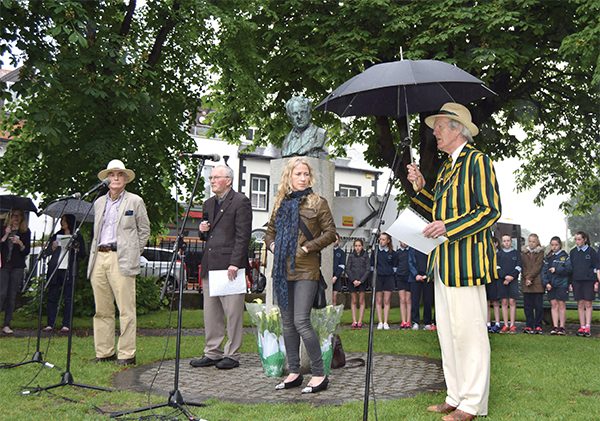
Above: Anthony Jordan (second left) with other performers on the day.
On Monday June 13th, celebrations were held at Sandymount Green to celebrate the birth date of one of Sandymount’s most illustrious sons, W.B. Yeats, who was born at No. 5 Sandymount Avenue on this date in 1865. The theme of this year’s programme was ‘Yeats and Easter 1916’.
Yeats was famously in love, to the point of obsession, with Maud Gonne. She married Major John MacBride, a Mayo man who shared her passion for political change and who was one of the sixteen leaders executed following the 1916 Easter Week Rising.
Yeats, understandably, was furious that McBride had stolen his muse of ten years and maintained an everlasting hatred for the man. The 1903 marriage between Gonne and MacBride was destined to fail. By the time their son, Seán MacBride, was born in 1904, their union was already doomed. Yeats continued to correspond with Maud, who lived in Paris with McBride during their marriage, and their letters are a valuable resource for scholars of literature and Irish history.
WB Yeats was in England when he heard of the Rising while Maud Gonne was in Paris. They were both shocked when they heard the news and Yeats felt cheated that he had not been informed. He wrote several poems commemorating the Rising, most famously ‘Easter 1916’, which also gave him an opportunity to publicly denigrate his rival, McBride.
These poems are now deservedly celebrated and are part of the mythology of 1916. Maud Gonne disliked ‘Easter 1916’ because she felt it unworthy, especially of her executed husband Major John MacBride, and she let Yeats know this in no uncertain terms.
The programme for this year’s Yeats Day celebrations was devised to illustrate this story.
Patrick Hugh Lynch began with ‘I am of Ireland’ where Yeats ‘declared’ as Irish. The 1916 Rising was part of the First World War and Charles Lysaght read ‘An Irish Airman foresees his death’.
We then had extracts from letters where Yeats and Maud Gonne reacted to the events in Dublin, read by John Houlihan and Lisa Gibbons-Kennedy.
The centre piece poem was ‘Easter 1916’ read in part by Niall Leinster, Margaret Pickup, Lorna Kelly and Joe McCarthy.
This was interspersed with three poems describing Yeats’s loss of Maud Gonne through marriage to Major John MacBride, and his understandable everlasting hatred of John MacBride; being reconciled to her again after her marriage failed, and a celebration of her power: ‘O do not love too long’, ‘Reconciliation’ and ‘No Second Troy’. These were read by Cathriona McAuley, Olive Hurley and Eleanor Collier.
A musical interlude was next, with Michael McAuliffe singing Down by the Salley Gardens accompanied on guitar by his son Ruairi.
Glynis Casson read Maud Gonne’s famous letter to Yeats rejecting his poem ‘Easter 1916’ as being unworthy of himself and of the participants, including her executed husband.
The sixth class girls of Scoil Mhuire performed a powerful three-part rendition of The Rose Tree under Donncha Cleary, followed by Jim Lucey reading Sixteen Dead Men, with Michael O’Reilly reading The O’Rahilly. Maurice Curran read Roger Casement, with Rodney Devitt reading The Ghost of Roger Casement.
Celebrated Yeats scholar, Anthony Jordan, then spoke about the twenty-year span of Yeats’s nominations for the Nobel Literature Prize before success in 1923. The programme concluded with repeat performances of The Rose Tree, Sixteen Dead Men and a recitation of Easter 1916 by Joseph Lynch.
All in all, it was a memorable celebration with the participants and audience looking their sartorial best, despite the rain.
The programme was devised by Anthony Jordan in collaboration with SAMRA, Sandymount Tidy Towns Committee and Declan Hayden of Dublin City Council.
By Jennifer Reddin



